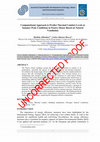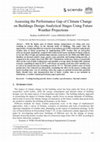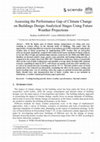Papers by Ibrahim Alhindawi

As the climate change casts its shadow on our future, while temperatures are rising in a noticeab... more As the climate change casts its shadow on our future, while temperatures are rising in a noticeable pace, thermal comfort in buildings are subjected to that effect in terms of future levels. This paper aims at evaluating thermal comfort levels in a pilot Passivhaus building, while integrating building simulation software, implementing new tools alongside the Passivhaus Planning Package, to produce multiple parameters as a detailed output for assessing the building indoor thermal status of users, during current and different future timelines and CO2 emission scenarios. Findings have predicted a set of PPD values for different timeline-CO2 emissions combinations, including recording a jump in PPD from 35% at the historical recent timeline of 2003-2017, to 94% at the timeline of 2080s of high CO2 emission scenario, during summer peaks at each timeline. Results have also identified a set of descriptive outputs regarding psychrometry, thermal sensation, and effective temperatures.

Journal of Sustainable Development of Energy, Water and Environment Systems
The Passive House building concept has been widely-researched in relation to its performance, esp... more The Passive House building concept has been widely-researched in relation to its performance, especially the aspects of energy consumption and thermal properties. Nevertheless, the design stages still do not present a dynamic thermal comfort predictive process that aids investigating the design performance. This research focuses on a methodology that calculates summer months peak conditions in a pilot Passive House dwelling in the United Kingdom, based on the natural ventilation plan effectiveness in maintaining sufficient airflows, while the mechanical ventilation-heat recovery summer bypass mode is on. The methodology's technical aspect involves EnergyPlus dynamic simulations, Ansys computational fluid dynamics simulations, and the Centre for the Built Environment Thermal Comfort Tool. The results presented showed a spectrum of predicted percentages of people dissatisfied ranging between 13.3-99.2% for different airspeeds. The majority were of uncomfortable levels at summer peak days. Results also presents the ranges of thermal comfort parameters simultaneously. The findings produced by the methodology may add a more comprehensive description to the thermal comfort status during design stages, employing the integrated software combination.

Environmental and Climate Technologies, 2020
With the higher pace of climate change, temperatures are rising each year, resulting in various e... more With the higher pace of climate change, temperatures are rising each year, resulting in various effects on the thermal status of buildings. This paper takes the opportunity of analysing different scenarios of greenhouse gas (GHG) emissions using hourly weather data of future projections by implementing EPW weather files on EnergyPlus software dynamic simulations, coupled with architectural science methods of climate analysis, to test the effect of high and medium-high emission scenarios for the 2050s and 2080s future timelines on thermal comfort range, passive zones potential, and heating/cooling periods, as compared to the weather data from 2003–2017. Simulations results have shown a remarkable effect on the scale of daily cooling hours and monthly coverage under the high GHG emission scenario, expanding its range by 60 %, with 6 hours on summer peak days and 3 months/year, as well as an annual decrease in heating period by 33.3 %. Thermal comfort zones of tested periods have also ...

Environmental and Climate Technologies, 2020
With the higher pace of climate change, temperatures are rising each year, resulting in various e... more With the higher pace of climate change, temperatures are rising each year, resulting in various effects on the thermal status of buildings. This paper takes the opportunity of analysing different scenarios of greenhouse gas (GHG) emissions using hourly weather data of future projections by implementing EPW weather files on EnergyPlus software dynamic simulations, coupled with architectural science methods of climate analysis, to test the effect of high and medium-high emission scenarios for the 2050s and 2080s future timelines on thermal comfort range, passive zones potential, and heating/cooling periods, as compared to the weather data from 2003-2017. Simulations results have shown a remarkable effect on the scale of daily cooling hours and monthly coverage under the high GHG emission scenario, expanding its range by 60 %, with 6 hours on summer peak days and 3 months/year, as well as an annual decrease in heating period by 33.3 %. Thermal comfort zones of tested periods have also witnessed an alternation, translating the effect on the passive cooling and passive heating zones' way of variating, where the ranges are pushed towards their potential limits. Results have also demonstrated that if future weather data is not included in simulations, a weather-related performance gap is generated.
Conference Presentations by Ibrahim Alhindawi

International Conference on Applied Energy, 2020
As the climate change casts its shadow on our future, while temperatures are rising in a noticeab... more As the climate change casts its shadow on our future, while temperatures are rising in a noticeable pace, thermal comfort in buildings are subjected to that effect in terms of future levels. This paper aims at evaluating thermal comfort levels in a pilot Passivhaus building, while integrating building simulation software, implementing new tools alongside the Passivhaus Planning Package, to produce multiple parameters as a detailed output for assessing the building indoor thermal status of users, during current and different future timelines and CO2 emission scenarios. Findings have predicted a set of PPD values for different timeline-CO2 emissions combinations, including recording a jump in PPD from 35% at the historical recent timeline of 2003-2017, to 94% at the timeline of 2080s of high CO2 emission scenario, during summer peaks at each timeline. Results have also identified a set of descriptive outputs regarding psychrometry, thermal sensation, and effective temperatures.

The 54th International Conference of the Architectural Science Association, 2020
Abstract: While the Passivhaus design approach and certification depend on the Passivhaus Plannin... more Abstract: While the Passivhaus design approach and certification depend on the Passivhaus Planning Package (PHPP) steady-state building simulations, including the natural ventilation assessment, design, and planning, this paper aims to assess the effectiveness and behaviour of the Passivhaus ventilation plan taken from the Passivhaus Planning Package (PHPP) natural ventilation tab through the implementation of Computational Fluid Dynamics (CFD), building modelling and simulation. The study approach provides useful and informative assessment for building designers to manipulate natural ventilation plans in a more efficient way, leading to a more accurate decision making and increased flexibility in the design process.
The results, through a case study, have unveiled the fact that airflow patterns are of an uncomfortable airspeeds at certain locations, surpassing 2 and 3 m/s at specific inlet air velocities, causing turbulence at some points of coverage, where these outputs could be implemented in adjusting the architectural design decisions regarding airflow direction.











Uploads
Papers by Ibrahim Alhindawi
Conference Presentations by Ibrahim Alhindawi
The results, through a case study, have unveiled the fact that airflow patterns are of an uncomfortable airspeeds at certain locations, surpassing 2 and 3 m/s at specific inlet air velocities, causing turbulence at some points of coverage, where these outputs could be implemented in adjusting the architectural design decisions regarding airflow direction.
The results, through a case study, have unveiled the fact that airflow patterns are of an uncomfortable airspeeds at certain locations, surpassing 2 and 3 m/s at specific inlet air velocities, causing turbulence at some points of coverage, where these outputs could be implemented in adjusting the architectural design decisions regarding airflow direction.